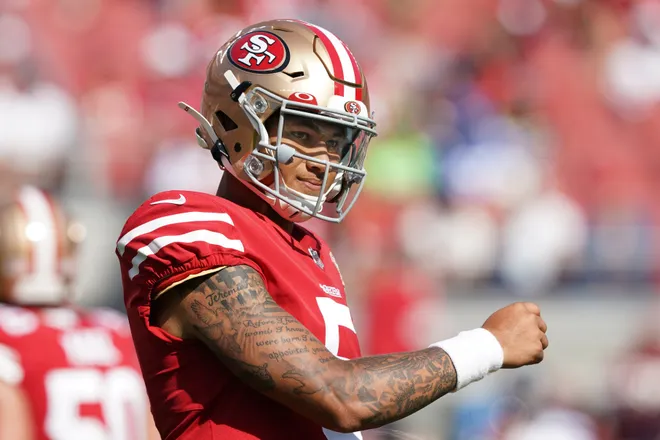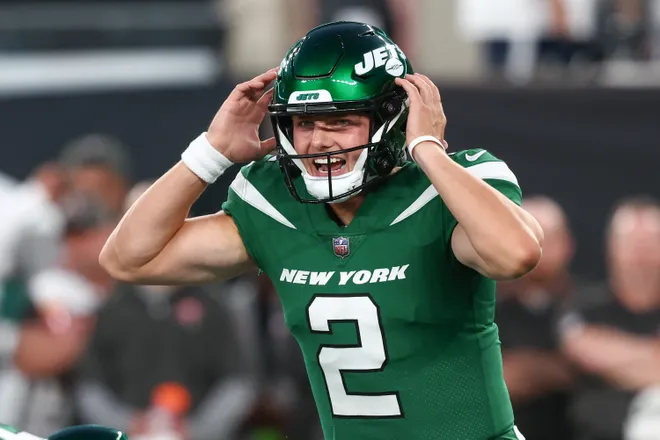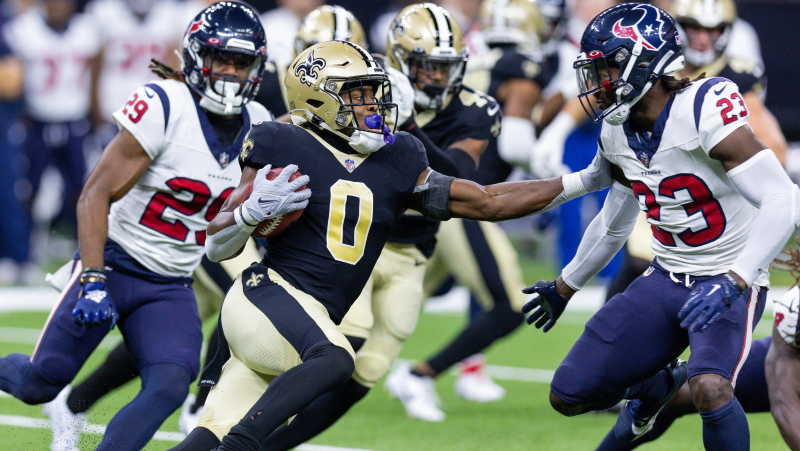Seven other young NFL quarterbacks in jeopardy of suffering Trey Lance's fate
The level of patience and security which NFL teams afford young quarterbacks, even those attached to very lofty draft selections, has apparently grown thinner than Bryce Young’s 5-10, 204-pound (allegedly) frame.
And the Carolina Panthers’ No. 1 pick atop this year’s draft – and his peers – surely took notice when the San Francisco 49ers cut bait on Trey Lance, the third overall choice in 2021, one that cost the Niners three Round 1 selections (plus a third-rounder) to acquire. Nevertheless, Lance was sent to the Dallas Cowboys for a fourth-rounder, hay pennies on the dollar but a return SF general manager John Lynch and head coach Kyle Shanahan were admittedly thrilled to salvage.
The runway to success for fledgling passers seems so short anymore, you better be Maverick Mitchell – able to get in the air immediately, regardless of circumstances, if you hope to survive. So even though the likes of Patrick Mahomes and Lamar Jackson – both were named league MVP in their second seasons – or Justin Herbert should probably be considered outliers, NFL teams want such near-instant results to be the rule of thumb.
"Everyone's trying to find the next Patrick," former league quarterback and current ESPN analyst Dan Orlovsky told USA TODAY Sports.
"There's such pressure to go win on Sundays ... that often does not coincide with development. It just doesn't.
PLAY TO WIN $10K: USA TODAY's Pro Football Survivor Pool is free to enter. Sign up now!
"And that could mean constantly relying on bad habits that allow you, at times, to get away with stuff – (that) certainly worked in college – but over the long haul, won't in the NFL. Young players have to wrestle with this ... and it can stunt your development or growth."
And that’s the tip of the iceberg in terms of factors conspiring to undermine underdeveloped signal-callers. Consider:
▶ Too many don’t have adequate foundational experience, Lance being a prime example, and there’s insufficient time for on-the-job training at the professional plateau.
▶ An ever-increasing salary cap and a more aggressive breed of GMs have led teams to pivot behind center more quickly than they used to given the greater financial margin for error.
▶ A desire to drop a young quarterback and his rookie contract into an otherwise stacked (and expensive) roster – again, this was San Francisco’s approach with Lance – means more pressure and less margin for error, from a performance perspective, extending from the front office down to the player.
“There's not a developmental league, there's not a whole field on the side where we can get our players just to practice to give him reps,” Shanahan lamented when reflecting on Lance's tenure, the coach putting much of the blame on his own shoulders.

Furthermore, Orlovsky notes the expanded skill set sought in franchise quarterbacks, traits that might lead to the likes of Joe Montana or Tom Brady no longer rating on pre-draft boards.
“The reality of having to be, nowadays, a three-way player has never been more true,” says Orlovsky. “You have to be able to beat teams with your arm, your mind and your legs, and you have to be able to do that at a consistent basis. If you don't have all three of those attributes at a high level, you have to be so elite at two of the other things, that it's really hard to find."
The Lance scenario is the starkest illustration of what seems to be a building trend. Johnny Manziel, Paxton Lynch, Josh Rosen and Dwayne Haskins are recent examples of first-round quarterbacks who were jettisoned by their original team before reaching their third season – though not all of their departures were solely football-related, and none was a top-five pick like Lance. The clock is even shorter for those not chosen in Round 1.
It’s an unmissable harbinger to 2023 rookies Young, C.J. Stroud of the Houston Texans and Anthony Richardson of the Indianapolis Colts – all with top-five status. Due to a pre-draft trade, Young cost Carolina more capital than just the top selection. Richardson is about to be thrown into the fray in Week 1 despite starting just 13 times at the University of Florida. All three are likely to determine the fates of their respective GMs, failure likely meaning a new personnel boss eager to find his own handpicked field general.
The shift may also dictate near-term fates of seven other quarterbacks drafted highly in the past four years, none likely to have much time to outlast their growing pains:
Zach Wilson, New York Jets

He was drafted one spot (second overall) ahead of Lance in 2021. And while no quarterback would feel shame in being supplanted by Aaron Rodgers, there was no doubt Wilson was going to be replaced as the NYJ’s QB1 by somebody in 2023 following two disastrous seasons that included an 8-14 record, 55.2% completion rate, 15-to-18 TD-to-INT ratio and 70.9 passer rating. His poor play was exacerbated by news conference stumbles, degraded fundamentals and, as Orlovsky points out, an offense that couldn’t mask Wilson’s greatest flaw – coping with pressure.
Despite a non-Power Five background at BYU and a college career most memorable for his pro day heroics, the Jets opted for Wilson to replace Sam Darnold, the No. 3 pick of the 2018 draft, largely to reset their quarterbacking salary scale even though the roster wasn’t in a strong position to support Wilson at the time of his arrival.
Rodgers has mentioned a desire to “play a few good years here and then hand it right back off to Zach, and let him go for the next 15.” And, thanks in large part to Rodgers’ tutelage, Wilson has looked significantly rehabbed during his extensive preseason playing time. The problem is, the Jets have to decide next spring whether to pick up Wilson’s fifth-year option and, like the 49ers, might have to pull the plug much earlier than they'd prefer given Rodgers’ presence and other financial commitments they’ll need to soon make to a suddenly impressive core of players.
Jordan Love, Green Bay Packers
His arrival as a first-rounder in 2020 signaled the eventual conclusion of Rodgers’ stay in Wisconsin. Rodgers won two MVP awards after Love came aboard, which explains why the new Leader of the Pack enters the 2023 season with one NFL start. Green Bay’s brass didn't activate Love’s fifth-year option, instead doing a fiscal compromise for 2024 that provided Love with a short-term raise while shielding the team’s financial exposure if he flops. He's looked sharp in the preseason, but there’s little to stop the Packers from charting a new course next year if he can’t maintain August’s momentum.
Malik Willis and Will Levis, Tennessee Titans
Both were widely projected to be first-round selections. Willis surprisingly tumbled into Round 3 last year, while Levis wound up as the second pick of the second round this spring. Despite Willis' impressive multi-dimensional tools, the Titans didn’t trust him enough to play him with the AFC South crown on the line at the end of his rookie season – instead tabbing journeyman Josh Dobbs to make the first starts of his NFL career with QB1 Ryan Tannehill sidelined. Tannehill is headed for free agency after this season, and it’s probable Willis and Levis will be pitted against each as the replacement option … assuming Tennessee doesn’t further diversify its QB portfolio in 2024.
Desmond Ridder, Atlanta Falcons
Also considered a fringe first-round prospect a year ago, he was the second quarterback selected in 2022 – though in Round 3, 12 spots before Willis. Ridder was fine, if unremarkable, while starting the final four games of his rookie season. He enters 2023 as QB1 for a team that could resemble last season’s Jets: oozing talent throughout the depth chart but with a massive question mark behind center. Positioned in a seemingly weak division, Ridder probably needs to win extensively now or otherwise risk being replaced by Taylor Heinicke in the short run and somebody perceived as better in the longer term.
Drew Lock, Seattle Seahawks
The 42nd overall pick in 2019, he started 21 games for the Denver Broncos – albeit putting an erratic array of outings on film – and was viewed as a major component of Seattle’s haul during last year’s Russell Wilson trade. Geno Smith’s resurrection and a bout with COVID-19 during preseason cost Lock his shot at starting in 2022, and he never played a snap in the regular season. He was exceptionally good this month, sporting a 69.1% completion percentage with three TD passes and a 105.1 QB rating. But there’s no guarantee the 26-year-old will get on the field in 2023 or earn an opportunity for his own career revival in 2024, when he’ll be a free agent.
Kyle Trask, Tampa Bay Buccaneers
A second-rounder in 2021 who spent his first two years parked behind Brady, Trask played very well in the preseason – Rodgers even gasping in admiration at one of his throws during the Bucs’ visit to the Jets – but was ultimately beaten out by Baker Mayfield.
Tampa Bay's modest-at-best outlook for 2023 suggests Trask will eventually get his shot, but Mayfield has a reputation for pulling off the unexpected, so...
***
Follow USA TODAY Sports' Nate Davis on X, formerly Twitter @ByNateDavis.

Disclaimer: The copyright of this article belongs to the original author. Reposting this article is solely for the purpose of information dissemination and does not constitute any investment advice. If there is any infringement, please contact us immediately. We will make corrections or deletions as necessary. Thank you.







